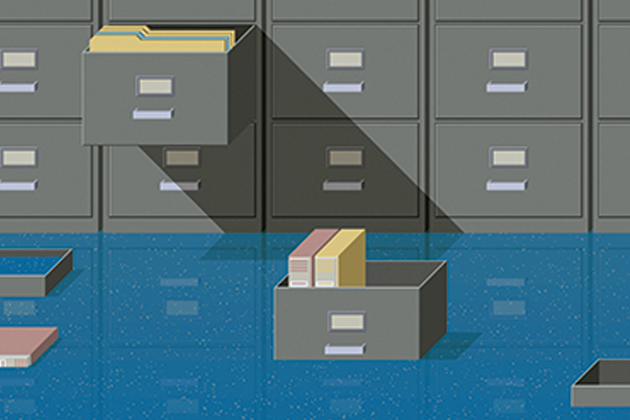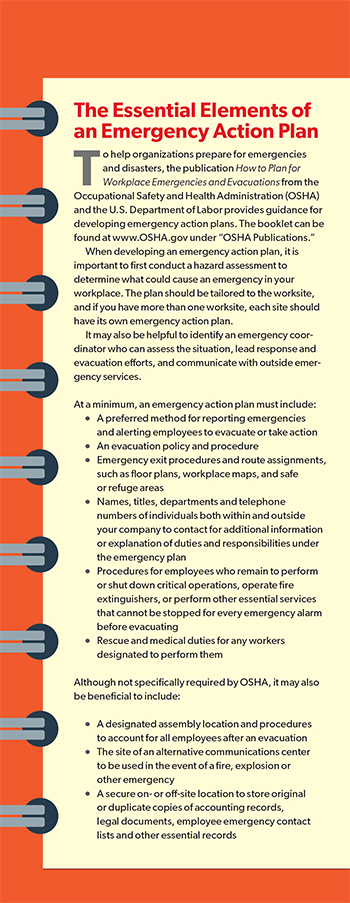
Every region around the world is at risk of experiencing extreme weather events, whether it is tornadoes, wildfires, winter storms, hurricanes, tropical storms, floods, earthquakes or volcanoes. Aon estimated that natural disasters caused $313 billion in global economic losses in 2022. In the United States alone, there were 18 major natural disaster events that resulted in at least $1 billion in damages last year, according to the NOAA National Centers for Environmental Information. In addition, data from the U.S. Census Bureau indicates that natural disasters forced an estimated 3.4 million people in the United States to leave their homes in 2022. While almost 40% were able to return in less than a week, nearly 16% never have.
As climate change makes extreme weather events ever more frequent and more severe, there is no reason to believe that 2023 will be any different. There is little that employers can do to prevent natural disasters from occurring. However, preparing for the impacts that a natural disaster may have on a business can help to keep employees safe and reduce the disaster’s economic impact on the business.
Developing an Emergency Action Plan

The Occupational Safety and Health Administration (OSHA) requires employers to provide safe and healthy working conditions, which includes protecting employees from unreasonable danger in the workplace due to natural disasters or other emergencies. OSHA defines a workplace emergency as a natural or man-made “situation that threatens workers, customers or the public; disrupts or shuts down operations; or causes physical or environmental damage.”
Before a disaster strikes, employers should identify reasonably foreseeable emergencies so that they can prepare an emergency action plan. Plans can include information like procedures to be followed in case of an evacuation due to fire or flooding, creation of a safe room to use in the event of a tornado or severe storm, and work-from-home rules in the event that extreme weather makes travel unsafe. For help in developing an emergency action plan and guidance on what it should include, employers should review the OSHA and U.S. Department of Labor resource How to Plan for Workplace Emergencies and Evacuations (see sidebar).
Once an emergency action plan is in place and has been communicated to employees, it is important that the employer provide robust training to all employees on what it contains. In a crisis, it is far more likely that employees will remember and follow the plan if they have been properly trained and have gone through emergency drills.
Communicating with Employees
Communication before, during and after a severe weather event or other emergency is critical, and plans for such communication should be included in the emergency action plan. Employees should know and understand how to communicate with their employer and how to obtain necessary information in the event of an emergency. It is difficult to think clearly in the midst of chaos, so it is important for employees to know in advance what they are expected to do.
Employers should maintain current contact information for all employees and have a process in place to ensure it is routinely updated. Some organizations implement a communication tree, where a few employees are designated to each call a list of people, each of whom calls another list of people, and so on until everyone has been contacted. Other employers use technology to send out a recorded message or group text, while some establish a call-in number for employees to save and use during emergencies. Whatever procedure the employer chooses, someone should be specifically charged with ensuring that it is followed during an emergency and that all employees are contacted.
Employee Compensation Requirements
The Fair Labor Standards Act (FLSA) outlines a number of regulations with regard to employee compensation, and employers should be familiar with them. There may be specific regulations that apply only to specific businesses or types of employees, but as a general matter, how employees are paid during a disaster will depend on if they are classified as exempt or non-exempt.
Employers are required to pay non-exempt employees only for hours actually worked, even if the reason for not working is a natural disaster or other emergency and not the employees’ fault. For example, if an employer closes the workplace and sends employees home in preparation for a potential natural disaster, there is no obligation to pay non-exempt employees for any time that they are not actually working after the closure.
However, there are potential exceptions for waiting time or on-call time. Examples of such exemptions include if the power is out at the workplace but employees are required to stick around in case it comes back on, or for non-exempt employees who receive fixed salaries for fluctuating workweeks. Also, if maintenance workers or nurses are required to stay on the premises, they must be compensated, even if they do not perform any work.
As for exempt employees, if there is any work performed during the week, employers are required to pay them their full weekly salary. Accordingly, if a workplace is closed due to a natural disaster or other emergency for less than a full workweek, the employer must pay the exempt employees’ full salaries for the week. If a closure lasts an entire week and exempt employees do not perform any work at all during that time, the employer is not required to pay any compensation.
Employers can require employees to use paid time off or other leave when they are unable or choose not to work because of a natural disaster or other emergency, but this policy should be clearly communicated to employees in advance. Ideally, this should be included in an employee handbook that is distributed to all.
It is also important for employers to protect their payroll and timekeeping records. In the event of catastrophic damage to the physical workplace, records may be lost, making it difficult or impossible for employers to process payroll. It is a good idea to maintain off-site electronic backups as they can be easily accessed if original records are no longer available.
Policies for Leave, Accommodation and Continued Employment
Following a natural disaster, employers can expect to receive increased requests for leave and accommodation. Employers should follow their policies for paid time off usage following an extreme event. In addition, the Family and Medical Leave Act (FMLA) requires employers with at least 50 employees to give unpaid leave to employees who cannot perform their jobs because they suffered a serious health condition such as physical or mental illness, injury or impairment, or must care for a spouse, child or parent with a serious health condition. This requirement may also be applicable following a natural disaster. Beyond the FMLA, there may also be state and local laws that require employers to provide leave. Additionally, mental or physical injuries resulting from a natural disaster can lead to increased requests for accommodation under the Americans with Disabilities Act.
If an employer instructs an at-will employee to come to work and the employee refuses to appear, unless they are otherwise legally entitled to leave or an accommodation, they can be subject to disciplinary action, including termination of employment. However, some local and state laws provide protection for employees who are under a mandatory evacuation order. Also, OSHA gives employees the right to refuse to work if they have a reasonable, good-faith belief that the working conditions are unsafe. Additionally, although state laws vary, employers should keep in mind that they (as opposed to a workers compensation insurer) may be responsible for injury to or death of an employee while he or she is working, if the injury or death was caused by intentional or grossly negligent conduct of the employer.
The bottom line for employers is to plan ahead and not wait until disaster strikes. A well-written emergency action plan and clear employment policies can protect employees and the employer, minimize confusion during and after an emergency, and help ensure that operations are restored as quickly as possible following any emergency-related shutdowns.
